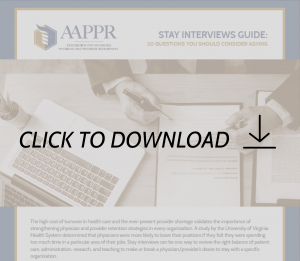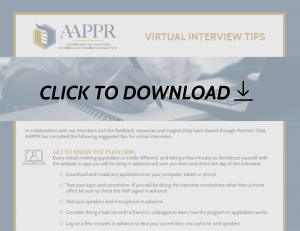resources
An Interview with the Board of AAPPR

We at Health eCareers had the distinct pleasure of hosting Carey Goryl, CEO of the Association for Advancing Physician and Provider Recruitment (AAPPR) at our offices. She was kind enough to organize a series of questions and answers among AAPPR board members on current trends, pain points and the role of AAPPR in physician recruitment. In this interview, we hear from AAPPR board members Tammy Hager, MBA, FABC, Lynne Peterson, MBA, FASPR, Robin Schiffer, FASPR, and Bruce Guyant, FASPR. Learn what these experts have to say.
1. What are the biggest pain points you have in your role?
Tammy Hager: Some of the biggest pain points in my role is not being able to get in-house physician and recruitment data instead of using search firm surveys and data.
Robin Schiffer: I have multiple roles. The biggest pain points are: Scheduling and credentialing locums. Hard to find specialties such as GI and Urology. Creating meaningful onboarding and retention strategies.
Bruce Guyant: Aside from just the sheer uber competitive market dynamics of a physician shortage, perhaps the biggest pain point is clinical leaders who do not have a strong enough sense of urgency in the hiring process.
Lynne Peterson: Besides the shortage of physicians, there’s not a lot of alignment between recruitment teams and operation teams. The operations team for example may not have realistic timelines and not fully know when to involve the recruitment team, and thus, finding the right candidate may not be successful if they don’t know the time it takes. For example, some specialties can take over a year to fill those open searches.
2. What are some interesting trends you’ve noticed in physician hiring?
Tammy Hager: Organizations, including mine, are using tools to hire for cultural fit more than ever. This includes making sure the entire family is a part of the recruitment process to retain the whole family. In addition, in our organization, telehealth is a big component for many of the physicians hired. We are using that to work with other organizations across the country to provide care. Rural communities are even tougher to recruit for, so we are having to have a personalized and strategic plan for every one of our rural practices.
Robin Schiffer: All specialties need unique approaches when you are in a more rural location. We have to wow the physician and family. Start friendships from the interview day.
Bruce Guyant: Despite a limited pool of candidates to draw from, most senior administrative and clinical leaders still expect their health system or medical group to maintain time to fill averages that are as quick or quicker than the competition or the rest of the industry.
Lynne Peterson: There seem to be more physicians of all specialties going toward hospital or ambulatory practice. Also, physicians are moving more readily from one organization to another, where in the past they stayed their whole careers in one place. They’re more likely to move if their employment isn’t going well.
DO ANY SPECIALTIES NEED UNIQUE APPROACHES?
All: We find that primary care, psychiatry, neurosurgery, rheumatology, and neurology all need unique approaches because of the shortage of physicians in these specialties.
3. How much are recruiters focusing on retention vs. hiring and what are the key ways that recruiters can influence job retention?
Tammy Hager: Our recruiters have a main focus on retention. We are taking a unique approach in how we reach out to physicians that have ties back to our areas (in the 4 states we serve). In addition, at Mercy Health, we reach out to residency programs that have a faith-based culture to recruit physicians to our faith-based system. Also, we have increased referrals from recent physicians we hired, and the recruiters do that by developing such a great relationship with them while going thru the recruitment and onboarding processes.
Robin Schiffer: AAPPR members that are in recruitment are working on finding a physician for the long haul. Sometimes recruitment firms are more worried about filling the position and getting paid. It depends on the firm. Some are excellent.
Bruce Guyant: The best way to influence job retention is to find the right candidate from the beginning. However, the truth is that recruiters have very little influence over the decision on the part of a provider to stay. Many organizations are seeing the value of having people on the team who are not recruiters who instead have focus on the on-boarding and retention piece full-time.
4. How do you think recruiters can ensure that the right physicians get in the employer’s door?
Tammy Hager: If recruiters truly look for physicians who fit culturally, have ties or spousal ties back to the locations/areas, and make sure the whole family is involved in the recruitment process, they can target those specific physicians.
Robin Schiffer: You don’t just look for skill. You look for a good fit culturally.
Bruce Guyant: The key is to understand your organization’s culture, team, and the needs of the position itself. The better you understand what is needed, the better you can appropriately assess “fit” upfront for your organization with the candidate’s needs and desires.
Lynne Peterson: Start the recruitment process early enough, and ensure that the proper screening is in place to get top talent. Know well in advance about credentialing and where the physician is in that process. At my organization, we do our checks and balances throughout the recruitment process to ensure the proper screening mechanisms are in place prior to offer and well before credentialing.
5. How do you feel physicians respond to in-house vs. 3rd party recruiters?
Tammy Hager: Many physicians do not know the different between in-house and 3rd party recruiters. We have to educate them, and we are doing that at Mercy with content on our physician career site, sharing content in specific magazines and journals that are sent to physicians, in residency program lunch and learns, and in email campaigns.
Robin Schiffer: I don’t think physicians realize the differences until they experience them personally.
Bruce Guyant: While Physicians are getting savvier and better at understanding the differences, most still do not know the differences. Even more really do not seem to care and just respond to each the same way and view them as a means to an end.
Lynne Peterson: I think it depends. On one hand, the 3rd party can advocate for them, but they’re not sure of the information they might get since the recruiters don’t get it straight from the organization they want to work for. The in-house recruiter has more in-depth reliable information, but they can be viewed as advocating for their organizations. It really comes down to what kind of kind recruiter they feel like they work with the best and how they go about their job search.
ARE MOST FULLY AWARE OF THE DIFFERENCES?
All: No
6. What are some of the most successful partnerships you’ve seen between in-house and 3rd party recruiting so that both are aligned in finding the best talent?
Robin Schiffler: It is really the recruiter at those firms. Sometimes you get lucky and find a gem!
Bruce Guyant: The most successful partnerships are those where communication has occurred up front with both parties fully understanding the needs and expectations of one another. Those who can do that and are respectful of the value of one another in the process will do well. I have personally had some excellent relationships with third party agencies who have sent me a high volume of quality and quantity of candidates.







